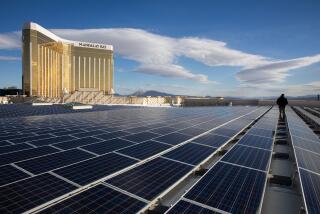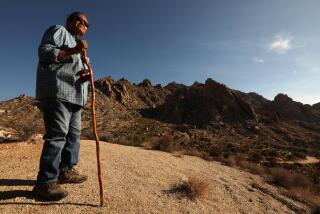Scientists Testing Verification : Soviets Set Up Shop Near Nevada Nuclear Test Site
- Share via
DEEP SPRINGS, Calif. — Equipped with seismic devices, computers and their own samovar, and expressing an avid interest in local snakes and scorpions, a team of Soviet scientists made camp Wednesday in a desolate Eastern Sierra canyon not far from where the United States secretly tests its nuclear weapons.
The nine scientists have received permission to conduct experiments to enhance their understanding of how detonations at the Nevada Test Site reverberate through the region’s volcanic geology. Similar tests were conducted last year by Americans at Karkaralinsk, a remote town near the Soviet nuclear range.
The exchange, initiated by U.S. scientists who advocate a total test ban, is being financed and administered by the Natural Resources Defense Council, a Washington-based environmental group, and the Soviet Academy of Sciences. The reciprocal missions are intended to demonstrate that any cheating on a nuclear test treaty could be caught through joint seismic monitoring.
“If we can guarantee full verification,” Nikolai Yukhnin, 44, head of the Soviet group, said Wednesday as his co-workers bustled about him, unpacking crates and running electrical lines, “it will be easier to agree on a test ban. So the experiments are very important.”
Whatever the scientific and political value of their mission, the mere presence of Russian-speaking scientists and technicians clambering freely among rocks just 120 miles east of the Nevada Test Site offered a symbolic measurement of how relations between the U.S.S.R. and this nation have moved since the days when President Reagan was calling the Soviet Union an “evil empire.”
Deep Springs, which owes its name to a saline pond that sits in one corner of a long valley, consists of a tiny private school and two ranches. The valley is split by a winding road that is rarely traveled. The site where the Soviets have established their camp is concealed from the road in the rear of a rocky canyon on federal lands.
“Same as Karkaralinsk,” Yukhnin said Tuesday night as he surveyed the cactus-covered expanse that spreads out below the Soviet camp.
Scenic Route Taken
The delegation had arrived late Tuesday after taking the scenic route from Reno to Big Pine via Lake Tahoe. The Soviets had spent much of last week in Reno, visiting casinos, toy stores and other attractions, as they waited for their equipment to be freed from a bureaucratic snarl involving U.S. Customs.
“Only play the nickel slots,” advised Boris Kazac, a computer specialist with the group. “These places always take your money, but with the nickel machines you can play longer.”
The duration of the journey from Reno to here Tuesday was extended when a California Highway Patrol officer pulled over the two vans carrying the Soviets and cited an American driver for crossing an unbroken yellow line. The driver, 24-year-old Edward Hodgman, a NRDC interpreter, said the Soviets were sympathetic.
“They told me,” Hodgman recalled, “that I should have stood in front of the car with a long face and tried to convince the officer it was the first time I had ever done anything wrong.”
When the party arrived, the NRDC’s Thomas B. Cochran, originator of the seismic exchange program, produced a bottle of Russian vodka to commemorate the moment. The vodka was poured into plastic glasses and, after toasts to scientific prowess and international cooperation, consumed straight and without ice--in hearty swallows by the Soviets and in tentative sips by the Americans.
The Soviets brought to the site two trailers and 18 cartons of equipment. One trailer will serve as the monitoring station, while the second will sleep two or three Soviets each night. The rest will be quartered at a motel in Big Pine, 27 miles to the west.
Mosquitoes and darkness quickly drove the party back to Big Pine Tuesday night, and work at the station did not begin in earnest until Wednesday morning. Throughout the morning, they arranged their electronic gadgets, dug holes for power poles and outfitted their trailer with canned ham and other foods, including caviar for any visiting dignitaries. One of the boxes marked fragile carried a pewter samovar for making tea.
At one point, Yukhnin asked what sort of snakes and scorpions inhabited the region. He seemed less than mollified when told that in the early spring the rattlers are thought to be lethargic.
The Soviets said it will take but a few days to get the station up and running. Afterward, they will begin to collect data on the everyday earthly vibrations, or “noise,” that registers on the sensitive equipment.
At the end of the month, American scientists affiliated with the NRDC and the University of Nevada-Reno will detonate at least three small dynamite explosions at underground sites throughout Nevada.
The seismic activity that these blasts generate will be monitored at three strategically placed U.S. stations, and by the Soviets. The Soviet delegation will be allowed to visit all sites connected to the experiments, although their only station will be in Deep Springs.
By measuring the effect of the explosions, the seismologists believe they can calculate precisely how the region’s soft rocks muffle seismic signals. This information, they said, can be used to determine how many monitoring stations would be needed to police bans on major weapons tests.
“The purpose of the experiment,” said Paul J. Allen of the NRDC, “is to demonstrate the efficiency of monitoring high-frequency seismic signals; to demonstrate that you can detect and locate and actually measure what is on an arms control scale a relatively small explosion.”
The scientific exchange program commenced before weapons negotiations between the United States and the Soviet Union resumed in Geneva. Those negotiations, while directed toward a stated goal of total elimination of nuclear weapons, have progressed in small, incremental steps. At present, the negotiators are attempting to resolve differences over how to verify compliance with a ban on tests of more than 150-kiloton force.
The U.S. government’s attitude toward the private scientific exchange has bordered on ambivalence. While not publicly criticizing the effort, Reagan Administration officials have expressed confidence that their negotiations with the Soviets is the best approach toward a test ban. The State Department initially refused to grant the Soviet scientists access to certain Nevada locations, delaying their visit by a year.
The Soviets here, like their American hosts, proclaimed that their goal is total abolition of nuclear weapons. “I don’t think there is any other path than disarmament,” said Yukhnin. “It is inescapable for survival.”
Yet he acknowledged there were obstacles.
“In the U.S.S.R., as in the U.S.,” he said through an interpreter, “there are people for whom work is military in nature, for whom this is money and work and their life.”
More to Read
Sign up for Essential California
The most important California stories and recommendations in your inbox every morning.
You may occasionally receive promotional content from the Los Angeles Times.














